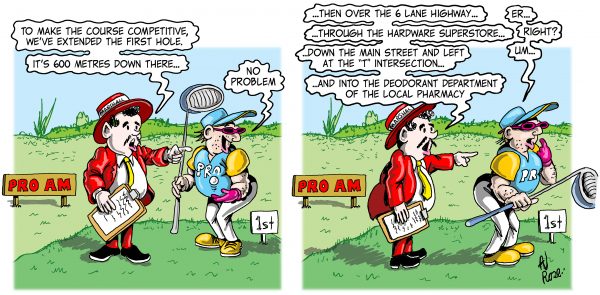
Watching Northern Ireland’s Rory McIlroy drive the green on the iconic Par-4 18th hole at St Andrews last month must have made some of the past generations question what exactly are the manufacturers doing to the equipment to enable such prodigious lengths off the tee. Or what about American Brooks Koepka muscling a 3-wood 380 yards on his closing hole at Erin Hills in this year’s US Open? Sure, Rory and Brooks are built like ironmen; fitness and athleticism are the buzzwords in modern pro golf, but some of the slight-framed pro golfers are also hitting previously unthinkable yardages with all 13 clubs in the bag. Let’s not forget, it was John Daly who broke the 4-minute mile in golf, by averaging over 300 yards off the tee. He was the first to do it in 1997. This year, 20 years after Daly burst onto the scene with his over-arching powerful golf swing, there are more than 25 players who average more than 300 yards, every time they peg up driver. If you don’t average more than 285 yards with driver you are 150th in driving length. Technology has changed the game, it is changing course design and history books, but what many of the elders are saying is that it could all be down to the golf ball.
Given that in 1919 The Royal & Ancient Rules of Golf Committee stated: ‘In order to preserve the balance between power and the length of holes and in order to retain the special features of the game, the power of the ball should be limited’ one asks the question, how can the golf ball not be under strict examination? Instead, all we see is golf balls flying further and further, untethered by regulation. 260 yards was the average driving length through the 1980s and 1990s, until the introduction of Oversized Drivers (1992) and further by Titanium drivers (1995) which saw a slight spike in average driving length going up by 10 yards and, of course, the phenomenon of John Daly. Once the death chime sounded on wound golf balls (around 2000) and were replaced by the multi-layered tour balls, 300 yards became the norm and it has changed the game. Most tour players are hitting it 30-50 yards further off the tee than they did in 1992 and some of the Senior Tour players are hitting it further now than in their prime years.
Some of the game’s greats all agree about how modern technology is affecting the game.
Jack Newton: “When I was on air during the Australian Open at Moonah Links [2008] we had one of the top dogs from the R&A in the commentary booth for a while; when we were off the air I said to him, ‘Mate, when are you going to do something about this golf ball going too far? It is threatening the history of the game; all the great courses are going to be obsolete and look at where we are, playing British Open courses that are 7, 700 yards long. It has no correlation to the average golfer. They wouldn’t even get around these championship courses, let alone play any good.’ He said, ‘We have got it on our agenda to look at it in 2012.’ Here we are banning long putters and the golf ball hasn’t been tossed up for discussion in any form for review. They slowed the ball down in tennis; why can’t we slow it down in golf?”
Peter Thomson: “As far as golf is concerned, that is the biggest disappointment in my life: that the authorities didn’t rein in the ball. It has changed the game so much.”
Jack Nicklaus: “I know the governing bodies are looking at it and they’re continuing to look closely at it. What they come up with, I wouldn’t venture to guess, but I know they will do what is in the best interest of golf. Right now, golf takes too much land. It takes too much water. It takes too much chemical. It makes the game take too long, and makes the game too hard. If you took a percentage away from what the golf ball does today, all of those factors would reduce and a great many of the 33,000 golf courses in the world would not be obsolete.”
Frank Phillips: “Look at Adam Scott around Kingston Heath when he won the Australian Masters (2012): all the bunkers were in the wrong place, there was no decision to be made off the tee, just take out the driver and bomb it over the traps. The only way they will bring these great golf courses back is if they slow the golf ball down, but they won’t do it. All it needs is to, say, slow the ball down off the clubface from 320 feet per second to about 250 feet per second … all of a sudden they have lost 50 yards. That is all it would take – 50 yards. I have been saying it for 25 years and Arnold Palmer said the same, but they won’t do it. Everyone loves to see someone hit it out there miles.”
Gary Player: “I think the modern golf ball has done golf an immeasurable amount of harm. I think the technology should be there for the amateurs, who are at the heart of the game. The golf ball has hurt the game with professionals because they have made the golf courses obsolete and everyone is trying to spend money on their existing golf courses around the world to make them tougher. It has hurt the game of golf. The members don’t like it. They have made golf too expensive. The clubs have got themselves into debt. They didn’t have to change their golf course because their course was absolutely bloody magnificent! They didn’t have to change anything at the sandbelt in Victoria, but they have changed many of them. It was unnecessary. They were beautiful, beautiful golf courses for the members and they loved it. Now, they changed them because pro golfers are hitting the golf ball so far. Just cut the ball back 40 or 50 yards with pro golf and you didn’t have to spend all that money and levy the members to get out of debt.”
Sir Bob Charles: “Technology is, more importantly, making great golf courses obsolete. The performance of a golf ball should be reduced to a maximum of 275 yards, which was the number one for distance statistics for Jack Nicklaus in 1967. For the record, that same year [1967] Arnold Palmer was at 272 yards, Gary Player 256 yards and yours truly at 245 yards. At age 76 I still hit the ball 245 yards, but I am 60 yards behind my son David and thus not competitive with him. The 31 yards I was short of Nicklaus 45 years ago was still reasonably competitive. Reducing the ball performance by 10% and shortening golf courses to a max of 7000 yards will help restore the magic.”
In June, Justin Thomas broke the US Open single round scoring record with a brilliant 9-under 63 and in the process he made Johnny Miller’s 40 year-old record fall and the internet light up with opinions about which 63 was better. Miller’s with persimmon headed clubs, steel shafts and an era where 300 yards off the tee was unimaginable, or the new era where Thomas hit his 300 yard second shot to three feet on the 670 yard par-5, with a 3-wood. The answer to which one is better is that they are not comparable and we can thanks the ruling bodies for allowing such a gargantuan shift in equipment and golf balls with little thought to the history books or the existing golf facilities.
So what are your thoughts on the modern golf ball? What can be done? Email your ideas to us at ed@insidegolf.com.au




![Win the golfing experience of a lifetime, at the Hawai‘i International Week of Golf, valued at $6,900 [Winner Announced] Win the golfing experience of a lifetime, at the Hawai‘i International Week of Golf, valued at $6,900 [Winner Announced]](https://www.insidegolf.com.au/wp-content/uploads/Hawaii-Comp-500x294.jpg)